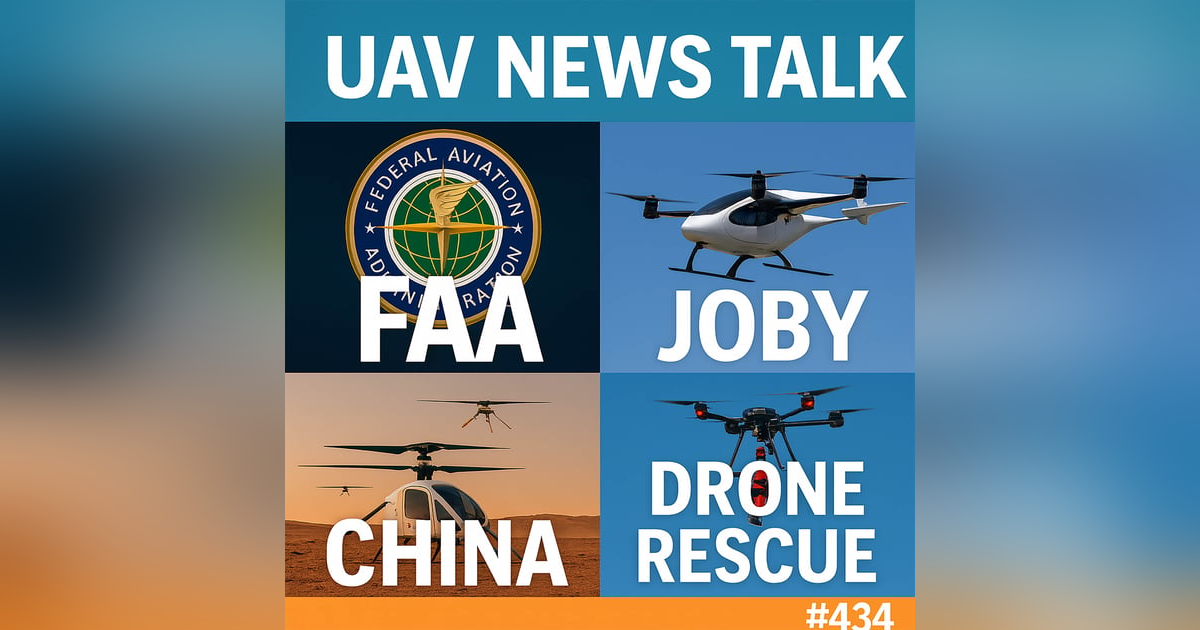Joby Buys Blade, China’s 2-Ton eVTOL, FAA Powered-Lift Rules & Drone Rescues

Max and David reunite for UAV News Talk episode 434, bringing listeners a wide-ranging discussion on the latest UAV, eVTOL, and rotorcraft developments.
FAA Advisory Circular on Powered-Lift
They start with the FAA’s release of AC 21-17-4, the long-awaited certification guidance for powered-lift aircraft. Max explains how this 64-page document emphasizes performance-based outcomes rather than prescriptive design rules. Much of the content resides in Appendix A, covering equipment from cockpit voice recorders to flight data recorders. The standout requirement: aircraft must withstand impacts from a four-pound bird—a test historically performed with frozen chickens fired from “chicken guns.” David points out that eVTOLs, operating at lower altitudes, will likely encounter more bird strikes than traditional aircraft, making the requirement especially relevant.
Joby Acquires Blade Passenger Business
The hosts then dive into Joby Aviation’s $125 million acquisition of Blade’s passenger business. Blade, known for helicopter and charter flights around Manhattan, gives Joby an existing customer base, operational infrastructure, and valuable experience. Max and David consider how quickly wealthy corporate travelers might switch from Sikorsky and Bell helicopters to Joby’s quieter eVTOLs. They expect a mixed fleet for years, with pricing likely used as an incentive to encourage adoption. The acquisition excludes Blade’s medical transport division but secures its premium commuter routes.
China’s Two-Ton eVTOL
China’s aviation industry stunned observers with the unveiling of a two-ton eVTOL. Although the aircraft carries 880 pounds of payload—comparable to a Robinson R44—Max notes the figure is underwhelming relative to the aircraft’s size. David highlights its 124 mph cruising speed and one-hour endurance, branding it part of China’s new “low-altitude economy.” Max contrasts U.S. and European reserve requirements for electric aircraft, noting that European operators can fly with only a 10-minute reserve, boosting usable endurance. They also reference the FAA’s MOSAIC rules, which propose pilot certificates requiring just 20 hours of training for simplified eVTOL controls—though both hosts believe real-world training times will be closer to 40 hours.
Ukraine’s Drone Bicycle Rescue
In a dramatic wartime innovation, Ukraine used drones to deliver electric bicycles to a soldier trapped behind enemy lines. After multiple attempts, including one foiled by a landmine, the soldier finally escaped thanks to the unusual delivery. Max appreciates this rare “good news” drone story, contrasting it with the common use of UAVs as weapons. David likens the aerial surveillance role to Vietnam-era A-1 Skyraiders providing overwatch during rescues.
Boeing Lawsuit and Startup Dispute
The discussion shifts to Boeing’s legal troubles with Zunum Aero, a Seattle-based hybrid-electric startup. After bankruptcy, Zunum sued Boeing for intellectual property theft. Though the case has bounced between rulings, the Ninth Circuit reinstated a $72 million verdict against Boeing, highlighting concerns about the aerospace giant’s corporate practices.
Waterfall Rescue with Drones and Helicopters
Finally, the hosts cover a California hiker who spent days trapped behind a waterfall in the Sequoia National Forest. Drones first located him before a sheriff’s helicopter hoisted him to safety. David jokes about future quadcopters equipped with hoists, while Max cautions hikers about the Seven Teacups Trail. The story reinforces the growing synergy between UAVs and helicopters in rescue operations.
Please check out these other podcasts in the Aviation News Talk Network:










